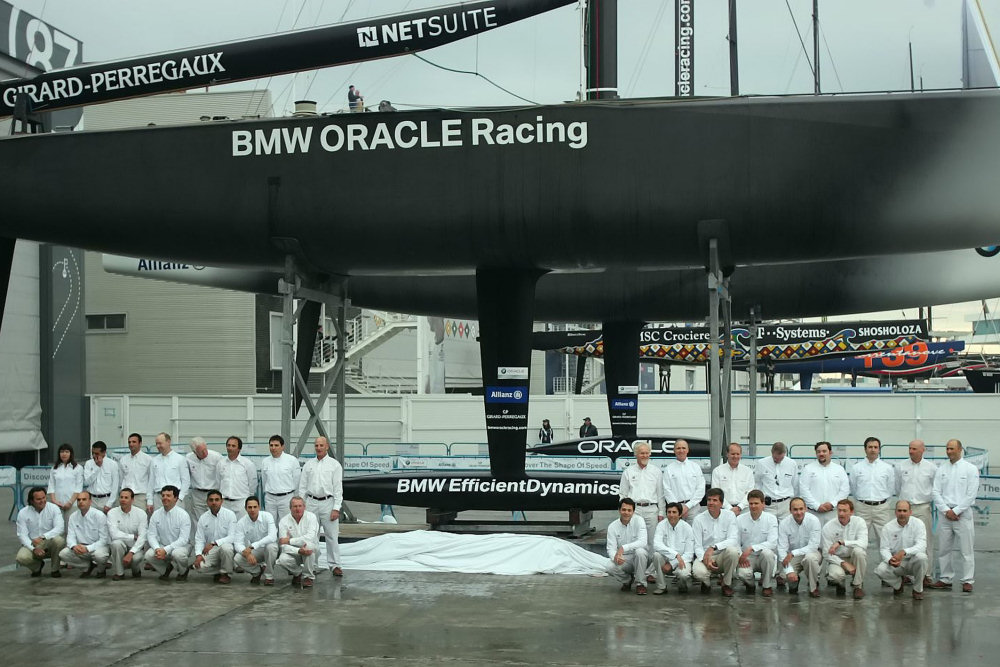
BMW ORACLE Racing unveils keel secrets
by BMW Oracle Racing 1 Apr 2007 12:40 BST
1 April 2007

32nd America's Cup unveiling day - BMW ORACLE Racing © Gilles Martin-Raget / BMW ORACLE Racing
Optimized Yacht Design Tailored for Conditions in Valencia
BMW ORACLE Racing dropped the skirts shrouding the underwater secrets of its two new-generation race yachts in Valencia today, revealing a refined rather than revolutionary package of keel, bulb, rudder and winglets.
“Today is a bit of America’s Cup theatre,” said team design co-ordinator, Ian Burns. “It is exciting to see all the skirts come off. For the design teams, it is a bit like taking an exam, but being allowed to look at your neighbour’s paper. After months of secrecy, suddenly all is revealed and out in the public domain for scrutiny and analysis. While the immediate attention is on the underwater appendages, this is really an opportunity for our 38-member design team to take a bow. We have worked hard to ensure that every aspect of the yacht, from the top of the mast to the bottom of the keel not only represents the state of its particular art, but also that everything works together.
“The whole design has been optimized for a balanced package, tailored to Valencia conditions and to the particular requirements and racing style of our sailing team.
“Of course, this is only the preliminary exam. The real test begins when the America’s Cup fleet goes into battle on the water, first for the Louis Vuitton Act 13 fleet regatta, starting on April 3 and then for the Louis Vuitton Cup, which starts on April 16.”
BMW ORACLE Racing CEO and Skipper, Chris Dickson said: “We anticipate some tough racing in the coming months, but we are confident that our entire performance programme – the designers, the boatbuilders, the mastmakers and sailmakers, the weather team, the shore crew and the sailing team – are ready to meet the opposition. We know that we will have to continue to refine and develop our equipment and our skills, but, thanks to a huge effort from the team and from our family of partners, sponsors and supporters, we are already a long way down our development track. We look forward to the start of racing.”
Under the rules of the event, from April 1, all the teams must cease using keel skirts to hide the underwater shapes and appendages of their yachts. By tradition, the teams open their bases for the day and allow the public and the media to see the yachts close up. Michel Kermarec, who leads the appendages program in the BMW ORACLE Racing design team, described the approach as a “classical configuration” – one keel, one rudder, no big surprises.
After the launch of the team’s first new yacht, USA 87, there was intense speculation about radical underwater arrangements. “This was sparked mainly because our mast was positioned well forward,” said Kermarec. “But, in fact, even though we have made changes to USA 87, there never was anything but a standard keel and rudder configuration underneath.”
Kermarec said the team had investigated a wide range of keel, bulb and rudder configurations in its search for a balanced combination specifically suited to Valencia’s weather conditions and the rest of the design package. The emphasis had been on rigorous refinement of the various underwater appendages and the engineering behind their construction and attachment.
During this process, 35 bulb shapes were tested in a high-speed wind tunnel and 100 theoretical shapes were subjected to CFD (Computational Fluid Dynamics) tests. Utilising hundreds of powerful computers, each of these CFD exercises represents about 30 hours of work, so that 3,000 hours of research was devoted to virtual bulbs alone.
The principal objectives are to concentrate as much weight as possible in the bulb for righting moment (stability), and to ensure that the shapes of the appendages direct the flow of water with minimum drag and maximum lift to drive the yacht forward with optimum efficiency. The steel keel strut reveals significant taper from the attachment to the hull progressively narrowing to the bulb attachment. Kermarec also noted that the trim tab on the trailing edge of the keel strut is relatively large. The rudder is fairly conventional, with the leading edge showing pronounced shape and the trailing edge virtually straight.
Kermarec said about 85% of the design effort went into the keel strut and bulbs, with less time spent on the winglets and rudder. The team has evaluated a range of bulb-winglet combinations for different wind conditions. Although the public is able to see the shapes and sizes of the keels and rudders, the invisible elements are just as important. The engineering involved in suspending a 19-tonne lead bulb from a slender steel strut attached to a super-light carbon-fibre hull is extremely demanding.
“The structural work to cope with these enormous loads is very impressive,” said Kermarec. The engineers and boatbuilders work to precise tolerances to ensure the attachment structures are as strong as possible and as light as possible. Lightweight engineering is one aspect of the innovative “EfficientDynamics” strategy of BMW. Through all development stages, BMW transferred the multi-faceted know-how from automotive research almost 1:1 to yacht construction.
It is not just a matter of making the attachments reliable. The steel struts in themselves represent a significant engineering challenge. The team had struts built in Germany (BMW Plant Eisenach), France and New Zealand. Under sailing conditions the struts are subject to constant oscillations. “There is a limit to the elasticity of the steel,” said Kermarec. “When the yachts are sailing in a straight line, the oscillations represent about 50% of that limit. When the yachts are crashing off waves, or spinning in those hard turns especially during the pre-starts, the inertia from the bulb takes the struts close to their extreme limits.”